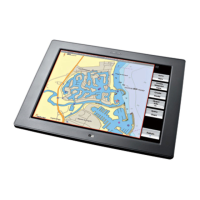¾
To change the orientation:
• Display the Radar screen and main menu. If you can't see the
Orientation button, select Return.
• Select
Orientation. There are three choices:
◦ Head Up means that the Radar screen rotates underneath
your vessel, so the direction in which you are heading is
pointing to the top of your
Radar screen. You can easily
compare the visual view in front of your vessel with the
Radar screen.
◦ North Up works only when heading data from a heading
sensor or COG is available. North is always at the top of
your
Radar screen. You can easily compare the Radar
screen to a
Chart in North Up.
◦ Course Up works only when heading data from a heading
sensor or COG is available AND there's an active route. It
means that your desired heading is always pointing to the
top of your
Radar screen so that you can compare the leg
bearing of the active route with the
Radar screen. (If you're
in Course Up orientation but don't have an active route, the
GB40 uses Head Up orientation until a route is made active)
Note: North Up and Course Up require heading data or COG to
operate. The quality of the heading data affects the stability of
the image so you're recommended to use a good quality
heading sensor.
8.7 Radar: Range offset (trigger delay)
Ideally, the Radar sweep should start at your vessel (a radar range
of zero). You may need to adjust the radar range offset (also
known as the trigger delay) to achieve this.
If the radar range offset is set incorrectly, your
Radar screen might
have a large dark circle in the center, or straight lines such as sea
walls or piers might have a curve or indentation. Objects close to
your vessel may be distorted. To rectify this, adjust the radar
range offset.
If your
Radar screen:
• has a large dark circle in the center, decrease the radar range
offset until it almost disappears.
• has no black circle at the center, increase the radar range
offset until a black circle just starts to appear at the center.
108 | Radar

